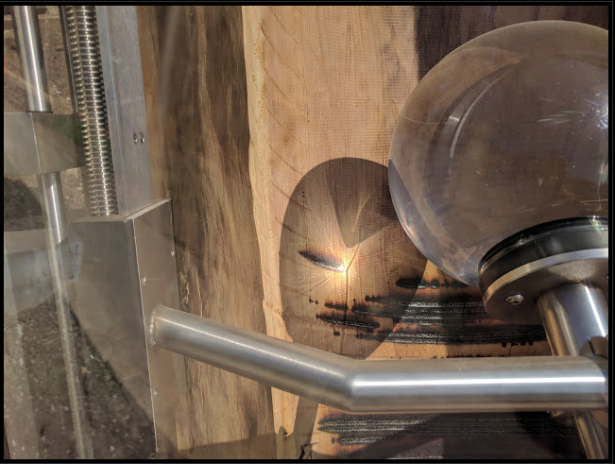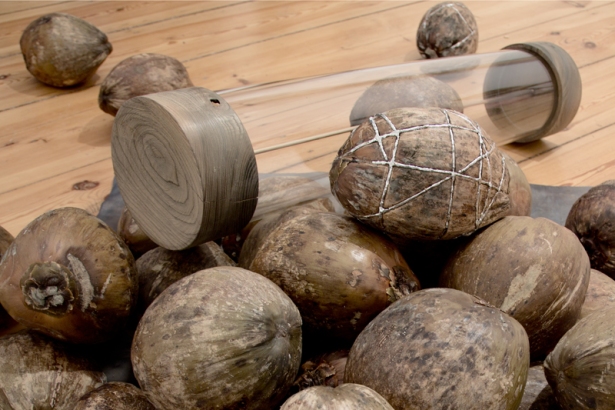This post comes from the Artists and Climate Change Blog
Wind-activated undulating walls and solar-activated etchings carved onto reclaimed redwood: the San Francisco-based artist Charles Sowers makes my heart sing!
Wave Wall from Charles Sowers on Vimeo.
I have always been inspired by artists working at the intersection of art and science. Sowers seems to do this seamlessly:Â weaving his love of science, architecture, meteorology and technology into mesmerizing installations that stop us in our tracks, drawing us in seductively to better understand our natural surroundings. He helps us to slow down, to notice natural phenomena that otherwise would have gone unnoticed.
As he explains on his Vimeo homepage: “I frequently collaborate with scientists to create works based on lab experiments. Through these collaborations, I have discovered a strong correlation between my process and that of the scientific experimentalist. We both build apparatuses –scientists to probe the limits of their collective understanding and I to probe the boundaries of beauty, delight, and wonder.â€
Of course, it is his renewable energy artworks that fascinate me the most.
Sowers’ most recent renewable energy installation – Solar Totems in the Glen Park Canyon Recreation Center commissioned by the San Francisco Arts Commission – uses a spherical glass lens (inspired by 19th-century meteorological instruments) to “write with sunshine.â€Â The glass sphere focuses the sun’s rays onto three southern-facing 12-foot-tall reclaimed redwood logs. As the sun moves across the sky, heat generated by the sphere’s magnified light burns a line from left to right across the log. Each line represents a distinct day with a unique weather pattern (sunny, partly cloudy, overcast, etc.)

Photo downloaded from http://blog.kwun.org/2017/08/solar-totems.html
Each day, the spherical lens is moved upward slightly by a solar-powered mechanism to create a new daily line. At the end of one year, the 365 solar etchings on the redwood log become a sculptural archive of the interaction of sun and weather patterns unique to this site. When the yearly record is complete, the heliograph mechanism is transferred to a second redwood log for the second year of etchings, and so on.
According to Sowers’ blog, at the end of three years “the three transformed logs turn the plaza [in front of the Glen Park Canyon Recreation Center] into a kind of civic solar and atmospheric observatory, artistically expanding our understanding of place and connecting us to our environment through that understanding.â€
This is a profound statement, especially in the context of climate change. Let me highlight it below:
“… artistically expanding our understanding of place and connecting us to our environment through that understanding.â€
This is what climate change artists do best: using metaphor to build awareness, a sense of connection and familiarity to overcome anxiety, fear and resistance. This, in my opinion, is the missing ingredient in the global climate change conversation. To help shift this conversation, we must find seductive ways — like Sowers — to draw our audiences’ attention beyond a collective sense of fear, apathy and hopelessness, to focus instead on the magical, wondrous world that sustains and inspires us. It must be protected, not only for ourselves, but for future generations.
Windswept is another renewable energy artwork by Sowers that I love: a wind-driven kinetic façade commissioned by the San Francisco Arts Commission for permanent installation at the Randal Museum. I admit to having watched this meditative video more than a dozen times:
Windswept consists of 612 freely rotating wind direction indicators mounted parallel to the wall creating an architectural scale instrument for observing the complex interaction between wind and the building. Wind gusts, rippling and swirling through the sculpture, visually reveal the complex and ever-changing ways that wind interacts directly with the built environment.
In his artist statement, Sowers explains “I seek to … reward extended observation. Sometimes this involves developing an apparatus to recreate and highlight some natural phenomenon observed in the world – the swirl of fog blowing over a hill, the formation of ice on a puddle, or flow of water and foam on the beach as a wave drains away. These things can fascinate yet often go unnoticed until pointed out. Other times I try to create instrumentation that allows us insight into normally invisible or unnoticed phenomena (emphasis added). The behavior of these interactions can be affectively or visually delightful and balance on the fascinating boundary between predictability and un-predictability.â€
I am looking forward to photographing both Windswept and Solar Totems next month during a trip to California to speak about my renewable energy photography at Women in Cleantech and Sustainability’s annual TED-style event hosted by Google. I hope to update this post with new images of Sowers’ beautiful installations upon my return. Stay tuned!
(Top image: Windswept by Charles Sowers, 2011.)
Follow Joan on Twitter: @CleanNergyPhoto
About Artists for Climate Change:
Artists and Climate Change is a blog that tracks artistic responses from all disciplines to the problem of climate change. It is both a study about what is being done, and a resource for anyone interested in the subject. Art has the power to reframe the conversation about our environmental crisis so it is inclusive, constructive, and conducive to action. Art can, and should, shape our values and behavior so we are better equipped to face the formidable challenge in front of us.
















